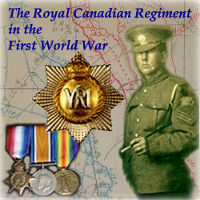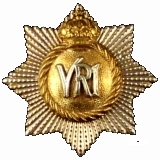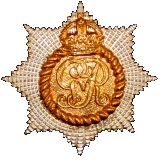
The First World War
An RCR Officer's Diary 1914-1918
OCTOBER, NOVEMBER, DECEMBER 1917
OCTOBER 1917
A draft of 34 other ranks arrived on 3rd [Oct]. The next day the enemy raided our trenches but we successfully repulsed. We suffered casualties in the hostile bombardment preparatory to the attack having 2 killed and 14 wounded.
In spite of the conditions under which the battalion had been, "C" Co. made a record in having no casualties although it had captured a M.G. and prisoners and undergone incessant Artillery fire.
On 5th [Oct] the battalion was relieved by the 25th Bn N.S.R. And returned to bivouacs at Ecuire.
The next day it left the Merricourt Area going by train to La Belle Epine and then by road to billets at Bailleul.
Lt Naylor left the battalion for the Royal Flying Corps and Lieut Hopkins for 8th Cdn Infty Bde.
On 11th [Oct] the G.O.C. First Army inspected 7th bde. A draft of 60 and 53 arrived on 13th and 16th [Oct].
On 15th [Oct] the battalion marched to Tincques where it entrained for Coda Waers Welde, marching 10 kilometers to billets at Predelles.
On 20th [Oct] Lt Col Hill, D.S.O., proceeded to England as an instructor at Senior Officers' School, Aldershot, and Major Willets assumed command of the battalion being promoted to acting rank.
On 22nd [Oct] H.R.H. The Duke of Connaught, Colonel of the Regiment, accompanied by H.R.H. Prince Arthur, inspected the brigade at Barre. The following day the battalion marched to Caestre and entrained for Ypres. From there they marched first to the St Jean Area and then to the Weiltje Area where they took over bivouacks, tents on sandbags, from 58th Cdn Bn. While there much heavy hostile bombing took place, this with heavy rain made conditions extremely uncomfortable. Until the end of the month the battalion carried out valuable working, carrying and stretcher bearer parties for the Heavy Artillery and 8th Cdn Infty Bde in the Passchendaele Area.
The conditions at this time were really terrible, the annihilating fire of our guns, the intense bombing day and night had pockmarked the surface of the ground as never before, the heavy rain on this turned the area into a sea of mud.
Communication was difficult and erratic and caused the position to be critical at all times. Runners were never despatched with messages until all other means had failed for fear of them becoming lost in the wilderness of shell holes or swallowed up in the mud. Visual signalling was much used when telephone wires had been broken and the small portable Lucas electric lamp proved invaluable.
Carrying parties and pack animals were the only means of bringing up supplies, ammunition, etc., and everywhere tracks had to be made. Needless to say these were well marked by the enemy and a crumped bath mat often meant great delay and sometimes a minor disaster.
Whenever possible roads and light railways were pushed well forward. The evacuation of the sick and wounded was naturally very difficult under these conditions and necessitated long carries.
The enemy had strongly fortified the last of the high ground to command Ypres, and hung on tenaciously with the aid of numerous machine guns housed in heavy concrete emplacements commonly known as pillboxes.
On top of all this the enemy made use of gas including a new form of gas shell containing mustard gas. This was most difficult to recognize with the result that many casualties occurred by men not donning their box respirators until too late. The liquid of this gas also percolated through the clothing and caused large sores and burns so that casualties were caused even with respirators on. This immediately gave rise to rumours that the respirator was not efficient, it took a considerable time to impress the troops to the contrary.
On 29th [Oct] the battalion relieved P.P.C.L.I. in the support line with headquarters at Otto Farm. "A", "B" and "D" Cos. were on Abrahan Heights, while "C" Co. sent two platoons to P.P.C.L.I. and two to 49th Cdn Bn to act as a reserve to these battalions who were attacking the following day. The 42nd Bn R.H.C. Were in Brigade Reserve.
On 30th [Oct] the brigade attacked Goudberg north-west of Passchendaele at 5.50 a.m. P.P.C.L.I. on the right and 49th Cdn Bn on the left, the battalion in support carried for them, this necessitated our men performing this duty in full fighting kit.
In previous attacks the decisive success had been spoilt by the enemy leaving large patrols out in no man's land in front of our barrage, this was possible under condition of ground and weather, these patrols held up our men in the assault. Orders were therefore issued for our patrols to clear no man's land, remaining there until just before our barrage commenced.
The value of Contact Aeroplanes for locating the position of our troops was brought out more and more owing to the lack of communication for notifying Headquarters, and the absence of landmarks by which units could identify their positions. Aeroplanes were also used to locate massing of hostile troops for the counter attack, so notifying our Artillery in time for them to break them up.
While "B" Coy carried for P.P.C.L.I. and "D" Coy for 49th Cdn Bn, "A" Coy worked under the Engineers.
Fortunately the night before the attack a strong cool breeze sprang up which somewhat dried the surface of the ground.
During the day some 30,000 rounds of ammunition was carried up to the attacking battalions. In the evening "B" and "D" Cos. reinforced P.P.C.L.I. and the 49th Cdn Bn and assisted in the captured position.
A system of light had to be established for the purpose of identifying the HQ of battalions in the Brigade by night, these were:-
The R.C.R. - Triangle of 3 white lights P.P.C.L.I. - Horizontal line of 3 white lights 42nd Bn (R.H.C.) - Inverted triangle of 3 white lights 49th Bn (Edmonton Regt) - Vertical line of 3 white lights
On 31st [Oct] "C" Coy and two platoons of "A" Coy relieved 116th Cdn Bn in Reserve at Pommern castle while "B" Coy moved from the old front line into the jumping off point of the previous day.
Lt Sykes and 19 men wounded and 2 were killed.
NOVEMBER 1917
"A" and "C" Cos. having completed their tasks returned to the Transport Lines on 2nd [Nov], the remainder of the battalion being relieved the next day by 2nd, 4th, 13th, and 16th Cdn Bns, returned to Pommern Castle.
Just previous to being relieved the battalion successfully repulsed a determined hostile attack to regain the all important high ground.
On the 4th [Nov] the battalion moved to Outskirt Farm.
During the action the battalion had one officer and 24 other ranks killed, ten officers and 211 other ranks wounded, and 13 other ranks missing. The strength on "going in" was 21 officers and 553 other ranks. The officer casualties were Lt Reed killed, Capt Poston, Capt Wood, Capt McCallum D.S.O., Lt Foster, Lt Wallar, Lt Mills, Lt Grant-Suttie, Lt Soule, Lt Wurtele and Maj Bouchard (attached) wounded.
Lt Col Carpenter returned to England.
On 5th [Nov] the battalion entrained at Ypres for Abele where it marched to rest billets at Watou.
On 7th [Nov] the battalion was inspected by G.O.C. 3rd Cdn Div and B.G. Cmdg 7th Cdn Infty Bde. Brig Gen Dyer, in appreciating the work done said:- "No finer test of a unit that that to which the Regiment was put, doing odd jobs for the assaulting units. The work was done and done well."
Capt F.D. McCrea rejoined and Lt H.F. Hicks with 94 other ranks reported. The battalion immediately commenced refitting and to train the new drafts.
On 10th [Nov] Lt Hopkins was wounded.
On 13th [Nov] the battalion proceeded by bus to Kruitstraat via Abele and Poperinghe, marching from there to their billets at Outskirt Farm.
On 14th [Nov] the battalion relieved 58th Cdn Bn astride the Passchendaele-Westroosebeke Road on a ridge just north of Passchendaele with Headquarters at Meetchele "Pill Box."
87th Cdn Bn, 4th Cdn Div, was on the right of "B" Co. in the front line and 42nd Bn R.H.C. On the left of "C" Co. P.P.C.L.I. were in close support and 116th Cdn Bn carried water, supplies and ammunition, etc.
Shortly after 58th Bn had been relieved, "B" Co. annihilated a party of 25 Germans who came over from 208 Res Regt and captured a machine gun.
Althogh there were actually no hostile counter attacks yet the Artillery barrages were almost incessant and it was a period of great anxiety.
1st Bn, 114th Infty Regt and 2 Bn, 117th Res Regt, were opposed to us and prisoners from there were taken.
2nd Bn Lincolnshire Regt, who the Regiment relieved at Bermuda in 1914 took over from the battalion on evening of 17th [Nov]
The battalion returned to Outskirt Farm on 18th [Nov] where it cleaned up after the tour.
In spite of the conditions under which the battalion had been, "C" Co. made a record in having no casualties although it had captured a M.G. and prisoners and undergone incessant Artillery fire.
On 19th [Nov] the battalion moved to Kuitstraat where [it] embussed for 1st Army area going via Bailleul, Hazebrouck, to billets at Robecq. Capt Logan, Lt Longley and 28 were wounded and 13 men missing during the last tour in the "Salient" and a total of 14 officers and 375 other ranks casualties for the Passchendaele offensive.
On 20th [Nov] the battalion marched via Busnes, Lillers, St Hillaire to billets at Rely where it remained for a month.
While at Rely Lts W.L. Barret-Leonard, J.C. Sutherland, J.W. Miller, W.H. Poole, A.M. Fraser, E. McDonald, A.E. MacPhie, also Lt H.R.S. Jones from 60th Bn, joined the battalion. Lt Wurtele and Capt J.S. Woods, M.C., rejoined from England.
Musketry, lectures including one on training to return to civil life, and general training was carried out. Sports and competitions were held. The officers of the battalion beat P.P.C.L.I. at baseball 10 - 9.
The band was detailed to play in Paris.
DECEMBER 1917
Polling for the general election in Canada, the main issue of which was the subject of Compulsory Military Service, was carried out. This resulted in an overwhelming majority for the Coalition Government under Sir Robert Borden, K.C.M.G., which immediately brought in the Military Service Act whereby all men over the age of 18 were conscripted for service overseas.
On 21st [Dec] the battalion moved by bus, with Portuguese personnel, to Fosse 10 where it relieved 27th Cdn Bn. two days later it relieved P.P.C.L.I. in a new part of the line on Souchez River.
Maj Garon was appointed O.C. 8th Cdn Area Employment Company at the end of the month.
- The O'Leary Collection; Medals of The Royal Canadian Regiment.
- Researching Canadian Soldiers of the First World War
- Researching The Royal Canadian Regiment
- The RCR in the First World War
- Badges of The RCR
- The Senior Subaltern
- The Minute Book (blog)
- Rogue Papers
- Tactical Primers
- The Regimental Library
- Battle Honours
- Perpetuation of the CEF
- A Miscellany
- Quotes
- The Frontenac Times
- Site Map

![]() The RCR in the Great War
The RCR in the Great War
![]() War Diary
War Diary
![]() Battle Honours
Battle Honours
![]() Battle Bars and The RCR
Battle Bars and The RCR
![]() The RCR Battle Bar Ledger (pdf)
The RCR Battle Bar Ledger (pdf)
![]() Honours and Awards
Honours and Awards
![]() Roll of Honour
Roll of Honour
![]() Prisoners of War
Prisoners of War
![]() Cemetery List
Cemetery List
![]() Cemetery Map
Cemetery Map
![]() Courts Martial
Courts Martial
![]() Officers
Officers
![]() RSMs of The RCR (1914-1919)
RSMs of The RCR (1914-1919)
![]() NCOs and Soldiers
NCOs and Soldiers
![]() An Officer's Diary (1914-1918)
An Officer's Diary (1914-1918)
![]() Recollections of a Nonagenerian (R. England) (1916-1919)
Recollections of a Nonagenerian (R. England) (1916-1919)
![]() On to Bermuda (1914-15)
On to Bermuda (1914-15)
![]() England and France 1915-1916 (Hayes; 1931)
England and France 1915-1916 (Hayes; 1931)
![]() Overseas with The Royals (1915)
Overseas with The Royals (1915)
![]() Regimental History Pamphlet (1917)
Regimental History Pamphlet (1917)
![]() Amiens (1918)
Amiens (1918)
![]() Cambrai (1918)
Cambrai (1918)
![]() Monchy-le-Preux (1918)
Monchy-le-Preux (1918)
![]() Under-aged Soldiers in The RCR
Under-aged Soldiers in The RCR
![]() Not All Were Volunteers; The RCR and the Military Service Act
Not All Were Volunteers; The RCR and the Military Service Act
![]() Sentenced to Death by Court Martial
Sentenced to Death by Court Martial
![]() The 7th Trench Mortar Battery
The 7th Trench Mortar Battery
![]() A Regimental Goat
A Regimental Goat
![]() Regiment and Family, Bermuda 1914-15
Regiment and Family, Bermuda 1914-15
![]() "March the Guilty Bastard In"
"March the Guilty Bastard In"
![]() Surrendered as Stowaway
Surrendered as Stowaway
![]() Re-Visiting the Great War Roll of Honour for The RCR
Re-Visiting the Great War Roll of Honour for The RCR
![]() Canadian Corps Trench Standing Orders (1916)
Canadian Corps Trench Standing Orders (1916)

